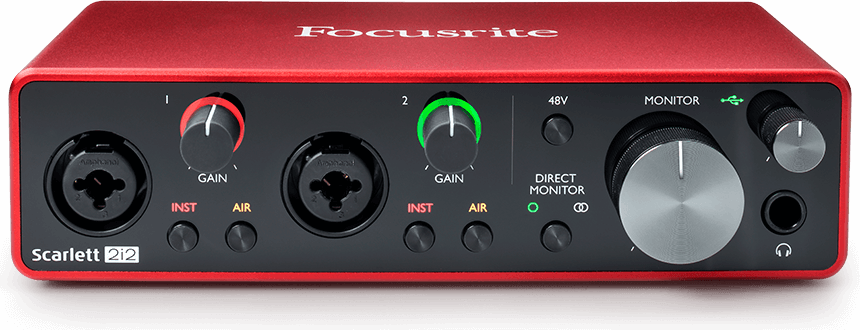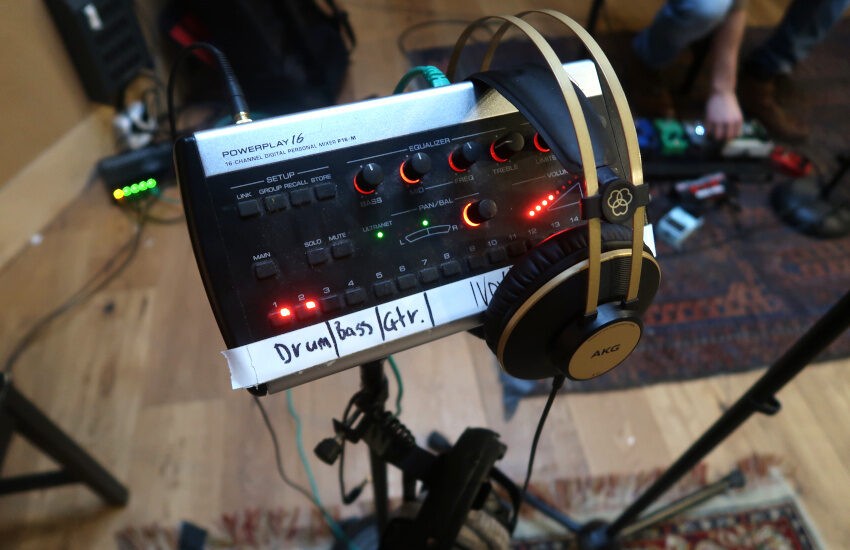Back in the day when you wanted to record your music, you had to go to a music studio, find an engineer and invest a lot of money. Nowadays though, it’s very easy to record yourself at home using only a few things. Amazing productions are created inside tiny bedrooms. Collaborating on recordings is also easier then ever since you can now record yourself anywhere in the world and just simply send your track over the internet. This article with help you get started with recording your bass guitar at home.
What gear do you need for recording bass at home?
First of all you need some basic gear to record. But what gear do you really need when recording yourself at home? Good question, luckily it’s not a lot. To get started, all you really need is a computer, a bass guitar, an instrument cable and an audio interface. Probably you already have most of this at home.
To make sure your recordings are sounding well, there are a few things you need to consider concerning your bass, instrument cable and audio interface. I will explain those next.
Making sure your bass is ready for recording
When it comes to your bass, be sure that it’s properly intonated. This means, that the bridge of your bass is set-up correctly and therefor all the notes are in tune. If the bridge of your bass is not set-up correctly, this can result in your bass notes getting more out of tune the higher up the neck you play. You don’t want your bass to sound out of tune!
Also your bass shouldn’t be rattling and/or producing an electrical hum. Both can really ruin a recording. This again has to do with how your bass is set-up and if the electronics are wired and shielded correctly. Contact a local luthier or your closest guitar store if you have any problems with your bass and they can probably set it up for you.
Your instrument cable
There’s nothing more annoying than a buzzing instrument cable. Make sure you have a cable that is in good condition. A lot of bass players save money on their instrument cable. Don’t be like those guys and girls and just invest a little bit more so you have a reliable one. They will outlive a cheaper cable by years which will save you money in the long run. Pro tip: Always have one or more spare cables handy.
Choosing an audio interface for recording bass guitar

So how do you connect your bass to your computer? Good question! You can use a so called audio interface. This is a little box that has one or multiple inputs, usually at least a gain knob and a volume knob, and is connected to your computer via USB, Firewire or Thunderbolt. There are many brands and makes that al have their pros and cons. Some things you might consider when choosing the audio interface that works for you are:
- Make sure it’s compatible to your computer. Not every computer has Firewire or Thunderbolt. Probably 99.9% of computers have a USB input. Also figure out which version of USB your computer/audio interface uses.
- Some audio interfaces have better preamps built in than others. This will affect how well your bass sounds if you plug it in directly.
- Since you are just beginning and probably don’t want to invest in an expensive software bundle, you should see which software is included with the audio interface. Be aware that some of the software included is only a light or compact version of the full software package. That might be good enough if you just want to record a single bass track, but might not be enough if you have producer aspirations.
- Are you just going to record bass or do you also want to be able to record other things? If you are just recording bass you probably only need an audio interface with a single input. If you however want to record some vocals at the same time, or want to make a recording where you have a direct signal and an amplifier signal. it’s better to have at least two inputs. Maybe you want to record drums one day? You will probably need more inputs even.
Invest in studio speakers for honest playback
Some extra gear you might want to purchase are some studio speakers. Studio speakers are designed to not color your sound. In other words, they are supposed to recreate the sound exactly as recorded. If you listen to your recording on normal stereo speakers or through headphones (which aren’t specifically created for the studio), they will always color/influence the sound. This is nice for listening to music but not nice if you want to do a mix that sound good on other systems as well.
Using an amp or preamp to get more tone control
What I like to do when I’m recording my bass guitar, is use a preamp (I’m using an Aguilar Tone Hammer) or my bass amplifier to color my sound and have more tonal possibilities. I can add some treble when I need it, boost the lows when I need a fat sound, etc.
You can usually connect both an amp and a preamp with an instrument cable or a XLR cable. When you use your amplifier without connecting a bass cabinet to it, be sure to check the manual beforehand. Not every amplifier can handle this and it might cause damage to it.
Mixing two bass signals
Once you get a little further into recording you might try some new recording techniques. One of them is to not only record your dry signal into the audio interface, but also simultaneously record a track of bass by placing a microphone in front of your bass cabinet.
Some engineers use the microphone track to record the low end of the amplifier and combine it with the clarity of the DI-signal to brighten up the bass sound. Other engineers use the amplifier to add a bass track with a mid boost on top of the direct track. You might also just use the amplifier track because you love the way your amplifier colors the sound of the bass.
The possibilities are endless. Combining multiple tracks adds a whole legion of new sonic possibilities to your recordings.
Recording to improve your bass playing
Everyone who has ever recorded themselves playing bass knows: It can be very confronting. A recording is always honest and you can hear every timing issue and unwanted sound clear as day. Although this can be offsetting at first, it is actually the perfect way to advance as a bass player. Being able to hear everything that’s going on, forces you to change the things about your bass playing that are lacking.
Conclusion
So to summarize, all you really need to record bass at home, are a bass guitar, an instrument cable and an audio interface. When you progress however, you probably want to get more out of your recordings and will most likely upgrade your recording setup with some studio speakers. By investing in a microphone to put in front of your bass cabinet and including a (pre)amp in your recording chain, you can improve your bass sound even further. In this way you can make sure your bass guitar sounds amazing in every situation and recording.
Being able to record your bass playing at home will allow you to collaborate with musicians all over the world. It will also have a huge impact on your bass playing since you will be forced to fix all the things your bass playing is lacking.
I hope you found this article helpful! Let me know in the comments what your thoughts are and if you have any questions or suggestions.

